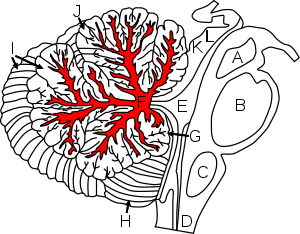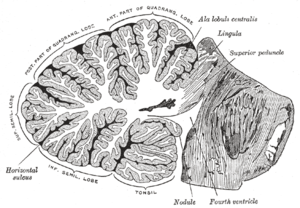Arbor vitae (anatomy)
The arbor vitae /ˌɑːrbɔːr ˈvaɪtiː/ (Latin for "tree of life") is the cerebellar white matter, so called for its branched, tree-like appearance. In some ways it more resembles a fern and is present in both cerebellar hemispheres.[1] It brings sensory and motor information to and from the cerebellum. The arbor vitae is located deep in the cerebellum. Situated within the arbor vitae are the deep cerebellar nuclei; the dentate, globose, emboliform and the fastigial nuclei. These four different structures lead to the efferent projections of the cerebellum.[2]
| Arbor vitae | |
|---|---|
 Figure shows cerebellum and surrounding regions; sagittal view of one hemisphere. A: Midbrain. B: Pons. C: Medulla. D: Spinal cord. E: Fourth ventricle. F: Arbor vitae. G: Flocculus. H: Tonsil. I: Anterior lobe. J: Posterior lobe. K: Inferior colliculus. L: Superior colliculus. | |
 Sagittal section of the cerebellum, near the junction of the vermis with the hemisphere. ("arbor vitae" visible as white space to left, but not labelled.) | |
| Details | |
| Identifiers | |
| Latin | arbor vitae cerebelli |
| NeuroNames | 692 |
| NeuroLex ID | nlx_anat_20090101 |
| TA | A14.1.07.401 |
| FMA | 72541 |
| Anatomical terms of neuroanatomy | |
Related
Godfrey Blount's 1899 book Arbor Vitae was ‘a book on the nature and development of imaginative design for the use of teachers and craftsmen’.[3]
Additional Images
 Animation of the right half of the human brain. Arbor vitae is illustrated in white.
Animation of the right half of the human brain. Arbor vitae is illustrated in white.- Arbor vitae
- Human brain dissection video (1 min 14 s). Describing the arbor vitae.
References
- Saladin, Keneth (2012). Anatomy and Physiology: The Unity of Form and Function. New York, NY: McGraw Hill. p. 526. ISBN 978-0-07-337825-1.
- Sodicoff, Marvin. "Cerebellum: Anatomy". Neuroanatomy Lab Resource Appendices. Temple University. Archived from the original on 20 April 2012. Retrieved 11 December 2012.
- Blount, Arbor Vitae, 1899
External links
| Wikimedia Commons has media related to Arbor vitae (anatomy). |
- aplab - BioWeb at University of Wisconsin System
- Stained brain slice images which include the "Cerebellum" at the BrainMaps project
This article is issued from
Wikipedia.
The text is licensed under Creative
Commons - Attribution - Sharealike.
Additional terms may apply for the media files.